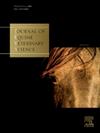Assessment of the impact of mycobacterium cell wall fraction (MCWF) on sperm parameters
IF 1.6
3区 农林科学
Q2 VETERINARY SCIENCES
引用次数: 0
Abstract
Mycobacterium cell wall fraction (MCWF) is a biologic used for the treatment of endometritis. Considerable research has been performed on this therapeutic, but with no consistency regarding treatment protocol. For ease of administration, many practitioners utilize intrauterine MCWF at the time of breeding. Intrauterine treatments should be avoided within 24 h of breeding due to the risk of uterine contamination and initiation of the inflammatory cascade in mares predisposed to endometritis. Therefore, the goal of this study is to evaluate the impact of MCWF on sperm parameters within breeding doses. We hypothesize that MCWF will not detrimentally impact sperm and can be added to breeding doses. To evaluate this, 7 ejaculates (n = 7) were collected and centrifuged at 200 × g for 10 min to reduce the seminal plasma and reconstituted in BotuPharma Gold at a concentration of 20 × 106 spermatozoa/mL. Doses were split into treated (1 mg/mL MCWF) and control (1.5 mL saline). Viability of sperm cells was assessed with a Nucleocounter. Additionally, total and progressive motility were assessed using computer-assisted sperm analysis (CASA). Doses were slowly cooled to a resting temperature of 4°C. Following cooling, aliquots were assessed for computer-assisted total and progressive motility, viability, and visually at 24, 48, and 72 h. Statistics were run utilizing SAS 9.4, and semen parameters were assessed using a 2-way ANOVA (MCWF vs. control) for repeated measures (T0, T24, T48, T72). Significance was set to P ≤ 0.05. When assessing viability, samples decreased with time (P < 0.01), but no effect of treatment was noted (P = 0.72). When assessing total motility on CASA, there was an overall decrease noted regarding treatment (P < 0.01) and time (P < 0.001), and when assessing individual time points, this decrease in total motility was only at T72 (P = 0.02). When assessing progressive motility on CASA, there was an overall decrease relating to time and MCWF treatment (P < 0.01), and this was noted at a decrease at all time points evaluated (P < 0.01). Due to debris within the treatment, visual assessment of motility was also analyzed, where a reduction in motility was noted at T72 regarding total motility (P < 0.01) and progressive motility (P < 0.01) when comparing MCWF treated to control. In conclusion, MCWF does not appear to impact sperm viability. CASA was found unreliable in this assessment due to debris. MCWF treatment was only found to impact visual assessment of motility at T72. This product may be considered safe for use with fresh semen, and additional work is needed to investigate its impact on long-term storage of cooled semen.
分枝杆菌细胞壁分数(MCWF)对精子参数影响的评估
分枝杆菌细胞壁组分(MCWF)是一种用于治疗子宫内膜炎的生物制剂。对这种治疗方法进行了大量的研究,但在治疗方案上没有一致性。为了便于管理,许多从业者在繁殖时使用宫内MCWF。由于易患子宫内膜炎的母马有子宫污染和引发炎症级联的风险,应避免在繁殖后24小时内进行宫内治疗。因此,本研究的目的是评估在繁殖剂量范围内MCWF对精子参数的影响。我们假设MCWF不会对精子产生有害影响,可以添加到繁殖剂量中。为了评估这一点,收集了7份射精(n = 7),在200 × g离心10分钟,以减少精浆,并在BotuPharma Gold中以20 × 106精子/mL的浓度重组。剂量分为实验组(1 mg/mL MCWF)和对照组(1.5 mL生理盐水)。用核计数器评估精子细胞的活力。此外,使用计算机辅助精子分析(CASA)评估总活力和渐进活力。将剂量缓慢冷却至静息温度4°C。冷却后,分别在24、48和72小时评估计算机辅助的总运动能力和渐进运动能力、活力和视力。使用SAS 9.4进行统计,并对重复测量(T0、T24、T48、T72)的精液参数使用双因素方差分析(MCWF vs.对照)进行评估。显著性设为P≤0.05。在评估活力时,样品随着时间的推移而减少(P <;0.01),但治疗无效果(P = 0.72)。当评估CASA的总运动性时,治疗后总体下降(P <;0.01)和时间(P <;0.001),当评估单个时间点时,总运动性的下降仅在T72 (P = 0.02)。当评估CASA的进行性运动时,与时间和MCWF治疗有关的整体下降(P <;0.01),并且在评估的所有时间点都注意到这一点(P <;0.01)。由于治疗过程中存在碎片,我们还分析了目测的运动性评估,在T72时观察到总的运动性下降(P <;0.01)和进行性运动(P <;0.01)。总之,MCWF似乎不会影响精子的生存能力。由于碎片,CASA在这个评估中被发现是不可靠的。MCWF治疗仅影响T72时运动能力的视觉评估。本品与新鲜精液一起使用可能被认为是安全的,但需要进一步研究其对冷却精液长期储存的影响。
本文章由计算机程序翻译,如有差异,请以英文原文为准。
求助全文
约1分钟内获得全文
求助全文
来源期刊

Journal of Equine Veterinary Science
农林科学-兽医学
CiteScore
2.70
自引率
7.70%
发文量
249
审稿时长
77 days
期刊介绍:
Journal of Equine Veterinary Science (JEVS) is an international publication designed for the practicing equine veterinarian, equine researcher, and other equine health care specialist. Published monthly, each issue of JEVS includes original research, reviews, case reports, short communications, and clinical techniques from leaders in the equine veterinary field, covering such topics as laminitis, reproduction, infectious disease, parasitology, behavior, podology, internal medicine, surgery and nutrition.
 求助内容:
求助内容: 应助结果提醒方式:
应助结果提醒方式:


